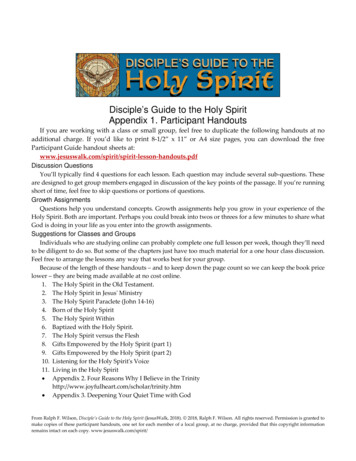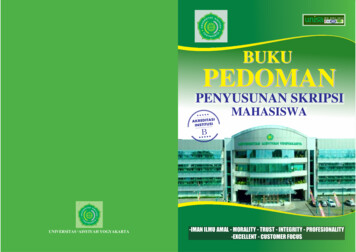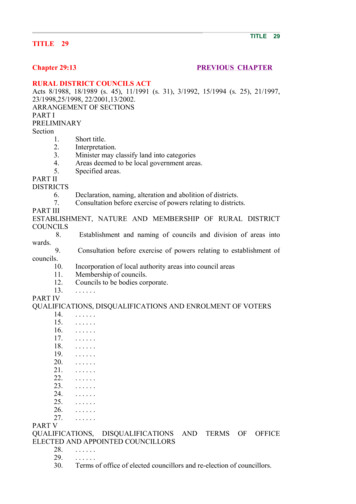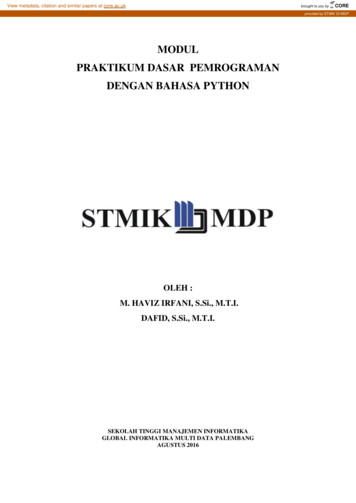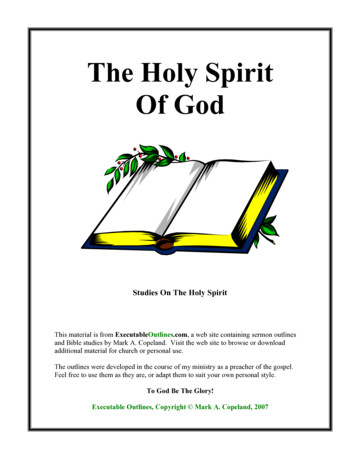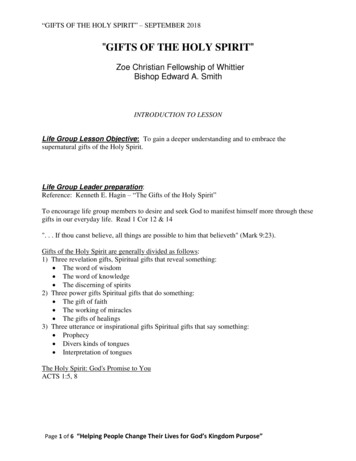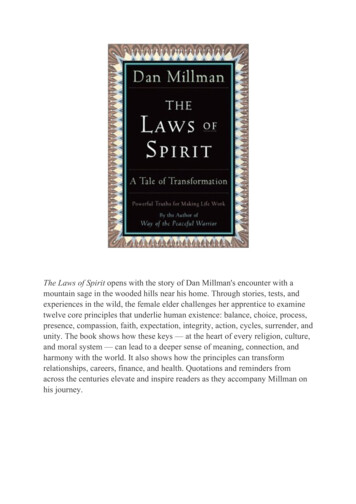
Transcription
The Laws of Spirit opens with the story of Dan Millman's encounter with amountain sage in the wooded hills near his home. Through stories, tests, andexperiences in the wild, the female elder challenges her apprentice to examinetwelve core principles that underlie human existence: balance, choice, process,presence, compassion, faith, expectation, integrity, action, cycles, surrender, andunity. The book shows how these keys — at the heart of every religion, culture,and moral system — can lead to a deeper sense of meaning, connection, andharmony with the world. It also shows how the principles can transformrelationships, careers, finance, and health. Quotations and reminders fromacross the centuries elevate and inspire readers as they accompany Millman onhis journey.
THE LAWS OF SPIRIT EXCERPTPrefaceWhat are the most important principles for living you’ve learned? Someyears ago, I asked myself this question. Since then, time and experience haveprovided answers and insights leading to The Laws of Spirit.This is not the first time I’ve written about spiritual laws: In Way of thePeaceful Warrior, Socrates refers to the laws of Spirit when he answers my questionswith a shrug, saying, “It’s the House Rules.” Body Mind Mastery introduces naturallaws leading to improved confidence and capacity in sports and fitness training; NoOrdinary Moments outlines universal principles to improve the quality of daily life;and finally, The Life You Were Born to Live reveals how to clarify the core issues ofyour own life path then presents specific laws to overcome hurdles on that path.Whether or not you are familiar with my other books or with writings onspiritual laws, I believe you will find the principles in this book especially clear andimpactful—maybe even transformative.All journeys are true, but not all are factual. In The Laws of Spirit I presentdeeper truths in fictional form through conversations and experiences with amountain sage—a woman of extraordinary wisdom and grace who teaches throughvivid imagery from the natural world.Unlike my previous, full-length spiritual adventures, this book is a teachingparable, not a full novel with plot and subplots, character development, or conflict atthe heart of drama. But in this narrative journey, you’ll find a transformative arc —my own — designed to conveys simple yet powerful truths that make life work(better).I invite you to travel with me up the mountain path. The climb won’t alwaysbe easy, but as we ascend, the sage shares in the most effective ways I’ve found, themost significant laws we’re destined to embody on the winding paths of life.These laws of Spirit belong to each and all of us. They are found within ourown hearts and in the heart of every religion, culture, and moral system. Bygenerating a profound sense of meaning and connection, they have expanded myperspectives and provided leverage to change the course of my life. I hope and trustthey will do the same for you.The Law of Balance: Finding the Middle Way
If gravity is the glue that holds the universe together,balance is the key that unlocks its secrets.Balance applies to body, mind, and emotions—to all levels of our being.It reminds us that anything we do,we can overdo or underdo,and that if the pendulum of our actionsswings too far to one side,it will inevitably swing to the other.“We’re downwind, so he doesn’t yet sense our presence,” said the sage softly,directing my gaze to the edge of the pond where a white bird balanced perfectly onone leg. Turning back to me, she asked, “Can you balance like the egret?”“What, you mean stand on one leg?”“I mean feel what the egret feels inside. Can you remain as calm in the midstof your everyday life?”“Yes. Maybe. I don’t know—I’m still trying to figure out how we got here.”Smiling, but ignoring my comment, she repeated her question. “You don’toften feel such serenity, do you?”“Well, no, I suppose not.”“An honest answer and a good starting point,” said the sage as she sat downon sunny knoll overlooking the pond. “Consider, for a moment, the importance ofbalance in the natural order of human life: Human beings are creatures ofmoderation: We can’t swim as well as fish, run as fast as cheetahs, fly as well assparrows, or lift as much as gorillas; but we can demonstrate all these abilities inmoderation, in balance.The sage pointed again toward the snowy egret, still poised at the water’sedge. “Every human body yearns for and thrives in a state of inner balance, innerpeace. “Can you feel it inside you now?” She placed her palm on my chest; I felt aprofound sense of peace pervade my body and quiet my mind.“You feel it,” she whispered.“Yes.” I sighed with pleasure.“This sense of serenity and stability will provide a reference point; it willincrease your awareness of, and decrease your tolerance for, the imbalances younormally experience.”
“In what way?”“Well, you can understand how it does little good to advise tense people torelax if they don’t know what ‘relaxed’ feels like. But once they experience a state ofdeep relaxation, they have a reference point; they can more easily notice tension as itarises and can take steps to release it. And once you know what true balance feelslike, you’ll begin to notice what’s out of balance in any area of your life; this servesas an automatic signal to return to that centered place within.“So you’re saying that I apply the Law of Balance simply by noticing myimbalances?”“Yes, and it’s quite simple, but not always easy, because whatever physical oremotional state you’re accustomed to feeling—even if it’s tension or extremeimbalance—will feel normal to you. So shifting to a state of true balance mayactually feel odd or wrong. What many people call ‘neurosis’ is an imbalance orexaggeration of a thought, impulse, insecurity, quality, or emotion we all feel attimes in moderation.”“Then how can one make the shift toward true balance?” I asked.A fish broke the surface of the pond, sending ripples radiating along itsmirrored surface as the sage responded: “Go to that quiet place, that still pond insideyou. Look, listen, pay attention to any ripples in your body or your life caused bydoing too much or too little in areas of eating, drinking, exercise, orcommunication.”As I considered this, another thought arose. “With everything going on in theworld today, spending all this energy looking inside and finding serenity seemskind of self-centered.”Smiling, the sage beckoned me to walk with her around the pond. “Manypeople confuse ‘self-centered’ with ‘being selfish’,” she said. “But once you findyour own balance, you also find the inner peace and inner power to make a realdifference in the world.”She bent over and picked up a thin, straight branch, several feet long, andproceeded to balance it upon one finger. The branch stood perfectly upright at first,as if by magic; then it began to move slightly to and fro, tilting forward thenbackward. “Desires and attachments pull you forward,” she said. “Fear, resistance,and avoidance pull you backward. Extremes of any kind—even taking rigid sideson an issue—can drive you out of that balanced place which embraces and values allsides of any issue. Do you understand?”
“I think so, but I’m not sure,” I answered.“Good—that means you’re ready to learn.”As we proceeded along the trail, I noticed that the sage stepped so lightlyover fallen branches I could barely hear her footfalls—her own state of balance wasexquisite. “Like all the laws I intend to share with you,” she continued, “the Law ofBalance is not just a philosophy but a way of life, with very practical applications.”Seeing my blank look, she picked up a stone, handed it to me, and pointed to a scrubpine about thirty feet away. “You see that tree trunk over there? I’d like you to hit itdead center with the stone.”I took a breath, aimed, and threw. I missed by few feet to the left. Shehanded me another stone. I threw again and got a little closer, but still to the left ofcenter. She then handed me four more stones, looked into my eyes, and spokeslowly. “It’s important that you hit the tree trunk with one of these stones.” I didn’tunderstand why it was so important, but I knew she meant it; I felt my heartbeatquicken.“Apply the Law of Balance,” she reminded me.“How?”“I’ve already told you that when you’re out of balance, it feels normal to you.Because of this, you keep leaning toward the familiar side. So the fastest way to findcenter is to overcorrect—to deliberately practice the opposite of what you’re used todoing. For example, if you speak too rapidly or too quietly for people to understandyou, then you need to deliberately talk in a way that feels ‘too slow’ or ‘too loud.’”“And since I just threw too far left,” I said, “I need to aim what feels like toofar right. Right?”“Right,” she said.“The thing is, I only have four tries remaining; I don’t want to miss that treeto the left or to the right. I want to hit it.”“I’m sure you do. But once you’ve worked both sides, it’s far easier to findcenter, whether you’re aiming at trees or doing anything else.”“I understand,” I said.“Doing is understanding,” she replied, pointing to the tree.Doubtful but willing to try, I deliberately aimed to the right; to my surprise, Imissed to the left again, but only by inches.“You see,” said the sage. “Accustomed to what you usually do, to what feelsnormal, you under corrected. That’s why changing any habit feels difficult, and why
many people learn so slowly. This time be daring! Make sure the next two throwsare to the right of the tree!”I made very sure; the first stone went a yard to the right; so did the second.“My last try,” I said nervously.“The Law of Balance will help you,” she said, “and so will I.” She led metoward the tree until I was only five feet away. “No one said you had to make lifedifficult,” she added with a smile. “If you notice you’re too far away, go too close!”Laughing, I hit the tree dead center.As we proceeded along the path around the pond, the sage about anotheraspect of this law: “Balance begins with the breath,” she said. “Taking in and lettinggo are the primal rhythms of life. Breathing in, you find inspiration; breathing out,you find release. Inspiring and expiring—birth and death with every breath.”“And notice how, when the rhythms of your breathing are out of balance, soare your emotions. So when you feel angry, accept it fully, and bring the breath tobalance. When you feel sorrow, embrace it tenderly, and bring the breath to balance.When you feel fear, honor it, and breathe deeply to find your balance.“As you exhale, you give; as you inhale, you receive. If you receive more thanyou give, you feel that imbalance as a need to reciprocate and complete the circle ofrelationship. If you give more than you receive, you deplete yourself of love andsimple pleasures, and eventually have nothing left to give.”“I’ve read about saints who gave much and received very little.”“So it may appear, but such beings experience abundant joy, love, andgratitude,” she responded. “The Law of Balance assures us that those who givefreely, in the spirit of love and generosity, receive in equal measure.”She took a deep breath, as if she had reached a point of closure, and beckonedme away from the pond, up a winding deer trail into the hills. As we hiked onward,I remembered something she had seen when we first met. “I was wondering howyou needed my assistance?” I asked. “You’d mentioned some kind of mission.”“This is part of your preparation,” she reminded me. “First learn the egret’slesson. Find balance in your life and in all things. Honor this law and follow in thefootsteps of the wise. Explore the range of human experience, but remember thathabitual extremes create stress. So always return to the golden mean, the middleway. Let your actions and words come forth softly, like the changing seasons. Fromthat inner state of balance, you’ll find the clarity to choose the paths of your life.”
As the sage’s words faded into silence, and we continued up into the hills, Iturned for a last glance at the snowy egret, still standing in calm repose at thewater’s edge.Continued in The Laws of Spirit available in print, audio and digital editions.(New World Library)TO PURCHASE THE LAWS OF SPIRIT DIRECT FROM THE PUBLISHER VISIT:https://bit.ly/39lLj3jDan Millman, a former world-champion athlete and college professor, is the author ofnumerous books, including Way of the Peaceful Warrior, Wisdom of the PeacefulWarrior, The Life You Were Born to Live, The Laws of Spirit, and The Journeys ofSocrates. His writings have inspired millions of readers in more than thirty languages.Dan teaches worldwide, sharing realistic ways to live with a peaceful heart and warriorspirit, transforming everyday life into a path of personal and spiritual growth. His workhas influenced men and women from all walks of life, including leaders in the fields ofhealth, psychology, education, business, politics, entertainment, sports, and the arts.You can explore more of Dan Millman’s work, read interviews about the 4 Purposes ofLife and the revised 24th edition of The Life You Were Born to Live, along with otherinterviews about and excerpts from more of his books at https://bit.ly/356FCCN
The Laws of Spirit opens with the story of Dan Millman's encounter with a mountain sage in the wooded hills near his home. Through stories, tests, and experiences in the wild, the female elder challenges her apprentice to examine twelve core principles that underlie human existence: balance, choice, process,


